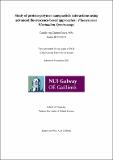| dc.description.abstract | Biologics are a class of drug products that are produced in part or in its totality from living organisms, one of the main examples of which are therapeutic proteins. During the production, processing, and purification steps, therapeutic proteins can inadvertently come into contact with nanoparticles – NPs – that may have a negative effect on protein stability. This, in turn, can affect product safety and viability, and ultimately may pose a risk to the patient. On the other hand, there are cases where NPs are purposely added to protein formulations in an effort to improve product stability, solubility, or as part of a drug delivery system. However, the current quantitative assessment of the effects of NPs on biological materials and systems is lagging behind, thus generating a problem for policy makers. Thus, it is paramount that a rapid screening technology is developed to safely identify potentially dangerous NPs based on their physicochemical characteristics. It is particularly important to understand the environmental factors that influence protein-NP interactions, and what are the characteristics that may promote unwanted protein aggregation, or alternatively, protein stabilization.
We sought to tackle some of these issues in this work by assessing the behaviour of a model protein – human serum albumin, HSA – and model polymer NPs – poly(N-isopropylacrylamide) and poly(ethylene oxide) – in solution and under different environmental conditions, using advanced fluorescence fluctuation spectroscopy approaches (FCS and PCH). Firstly, we proceeded to study Alexa 405’s diffusion and photophysics in media of increasing viscosity, composed of glycerol:water mixtures, using conventional spectroscopy methods – such as absorbance and fluorescence spectroscopies – as well as FCS and PCH. Seeing as there is a dearth of reliable fluorophore standards that can be used for near-UV, 400 nm excitation with FCS, we studied Alexa 405’s behaviour and determined its suitability as a standard for calibration of the fluorescence microscope’s confocal volume. We determined the diffusion coefficient of Alexa 405 in water, 333 μm2/s, as well as its fluorescence its quantum yield (0.93) and fluorescence lifetime (3.56 ns) for the first time. This fluorophore proved to be photostable above pH 4 and reliable for the labelling of HSA.
Subsequently, the non-specific interactions of polymer NPs with three fluorophores – Alexa 405, Atto 390, and Atto 425 – were studied using FCS. We evaluated the effect of polymer concentration on the diffusion of small probes, and attempted to determine the size of the polymer NPs using FCS. PNIPAm NP’s size was successfully determined without the need for covalent labelling. The hydrodynamic radius of three types of PNIPAm (MWs 20-40, 30, and 40 kDa) was determined as ~3 nm, which is comparable to that of HSA. We also established the PNIPAm and PEO concentrations that would not cause diffusion slowdown of HSA due to macromolecular crowding. Atto 390 in 0.5 wt% PNIPAm was the best system to size the polymer, since the attractive interaction between the fluorophore and the polymer was strong enough to allow for complexation, and the polymer concentration was low enough to not cause diffusion slowdown or anomalous diffusion.
In the last part of our study, HSA was covalently labelled with Alexa 405 (A405HSA), and a thorough study of the protein’s stability in solution with either of the polymer NPs – PNIPAm or PEO – and under different environmental conditions – shear stress, pH, ionic strength, and temperature – was evaluated by FCS and PCH. We noticed that A405HSA formed protein-polymer complexes under specific environmental conditions. These were driven by either: i) a mechanical force in the form of shear stress, ii) an increase in temperature to 70°C, or iii) electrostatic attraction. In the absence of the polymer NPs, A405HSA experienced extensive aggregation as a result of the combination of shear stress and adsorption to an air-water interface, and A405HSA aggregates were as big as ~800 nm. When either of the polymer NPs was in solution under the same conditions, they formed stable complexes with A405HSA, which protected the protein against aggregation. In another scenario, A405HSA-PEO complexes were formed when the sample was heated to 70°C, which was likely facilitated by protein-polymer hydrophobic interactions. Additionally, at pHs 3 & 4.7 A405HSA in the A405HSA-PNIPAm sample experienced extensive aggregation which was driven by protein-polymer electrostatic attraction. These results helped us to derive important conclusions with regards the stability of proteins in solution with polymer NPs: i) where there is potential for protein-polymer electrostatic attraction, unwanted protein aggregation may occur, which in our case was facilitated by the polymer; ii) when the polymer is neutral, or when both protein and polymer bear the same charge (in the presence of dissolved salts), the polymer NPs can protect and stabilize the protein against aggregation by forming protein-polymer complexes. | en_IE |


